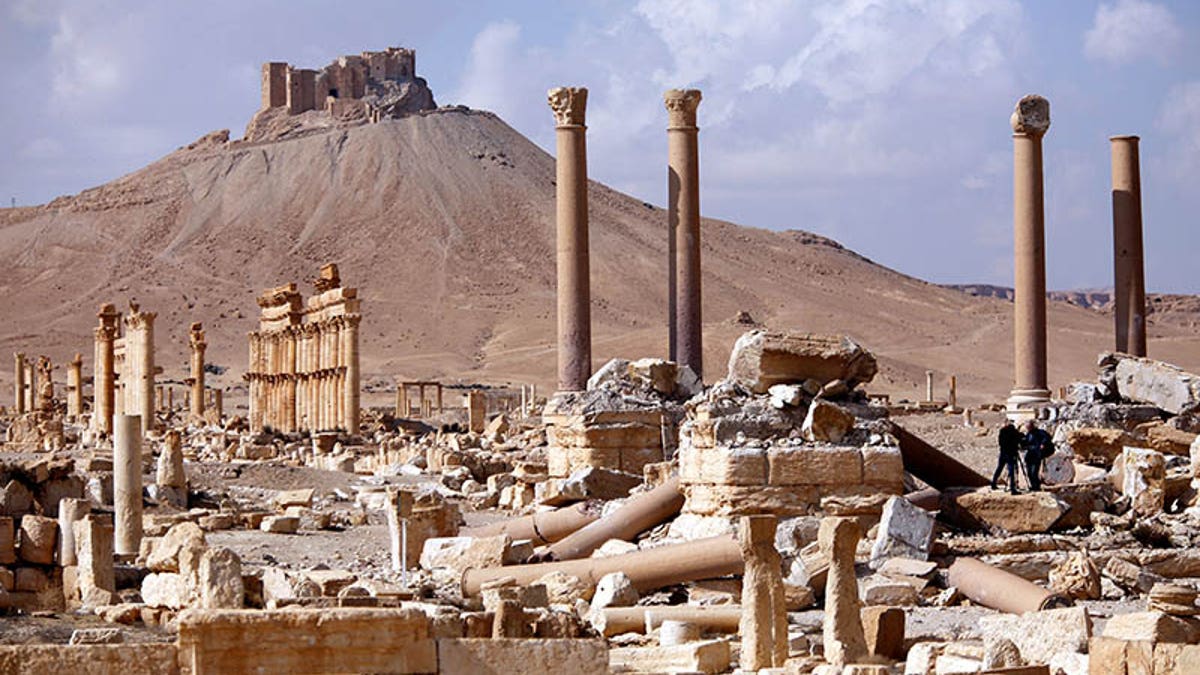
Laid to waste: Palmyra after ISIS onslaught. (REUTERS)

Ancient artifacts "Abu Mohammed" is selling to clients he claims mostly hail from Europe and Gulf Arab states. (Daham Alassad)

Small signs of splendor are left in the largely destroyed ancient city of Palmyra. (REUTERS)
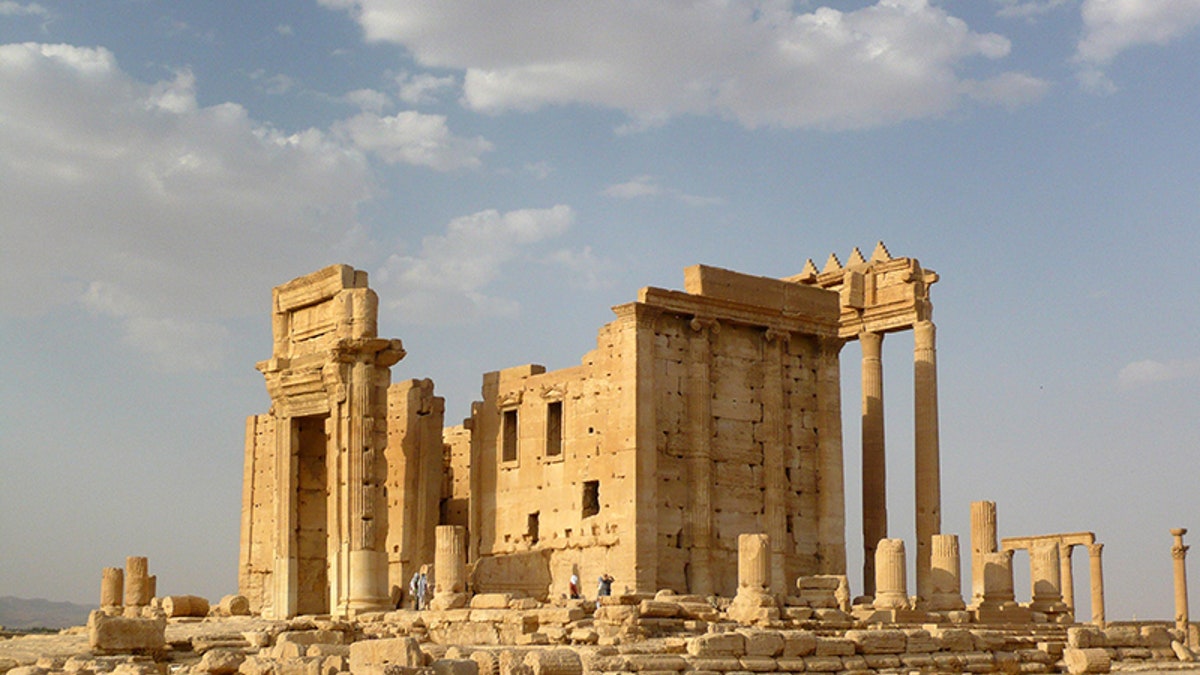
Palmyra before the war (REUTERS)
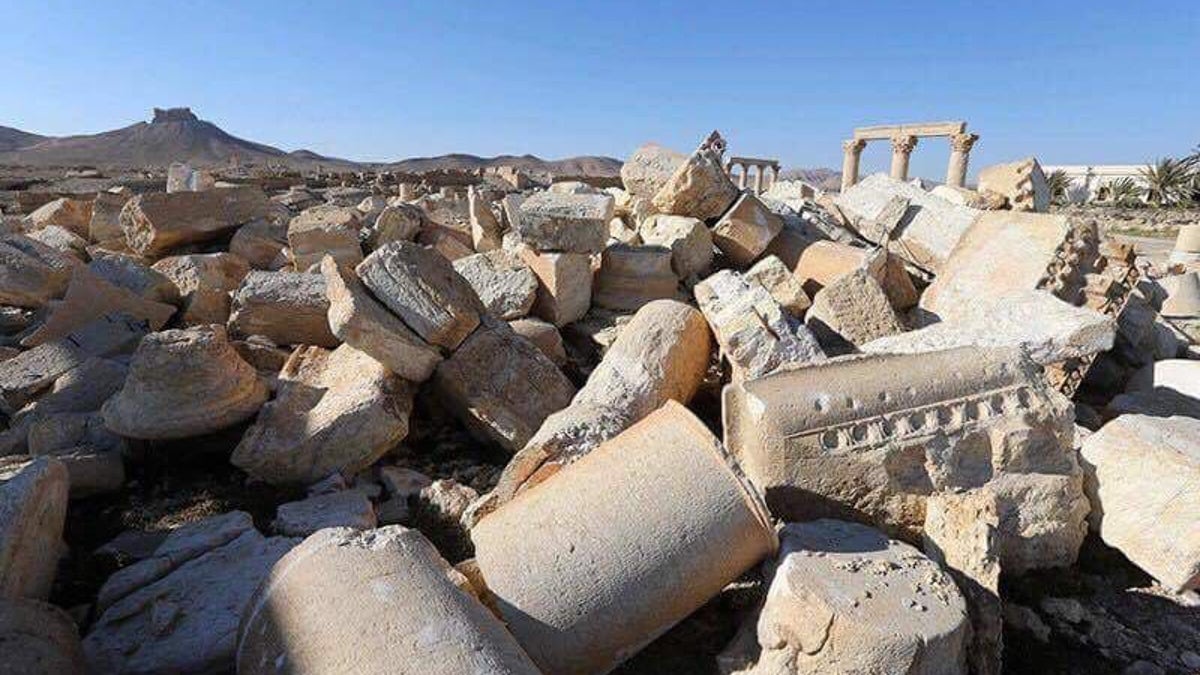
Reduced to Rubble: Palmyra's old city in 2017 (Fox News)

"Abu Mohammed" selling artifacts, which he claims to be from ancient Palmyra in Syria, on the black market in southern Turkey. (Daham Alassad)

Gold and small coins, presumably stolen from Syria's Palmyra, on the black market in Turkey (Fox News/Daham Alassad)

Items being sold illegally by Palmyra native who goes by the name Abu Mohammed. (Daham Alassad)
PALMYRA, Syria – The Syrian city of Palmyra stood for decades as a shining example of ancient civilization, a caravan stop on the Silk Road that served as the capital of Queen Zenobia’s empire.
The city’s meticulously preserved Greco-Roman ruins landed it UNESCO World Heritage Site status, making it a top tourist attraction in the Middle East and a mecca for archaeologists and historians.
Now the city once known for its priceless ancient art and artifacts has been ravaged by ISIS, the terror group that has defiantly destroyed the cultural heritage of the lands they occupy. But even as it set about destroying some of the world’s most priceless and beautiful structures – declaring many of the treasures sacrilegious idolatry -- ISIS also launched the highly profitable trade of selling these supposedly unholy relics on the black market.
Now that ISIS has largely been driven from Palmyra, Fox News got an up-close look at the destruction the group wrought on what only a few years ago was a stunningly preserved ancient city.

Palmyra's amphitheater after the ISIS terror group occupied the city. (REUTERS)
Before the terrorists swept in, the old city of Palmyra, or Tadmur as it is known locally in Arabic, was something of an archaeological sanctuary deep inside the south-central desert of Syria. It was the country’s premier site for studying ancient Greek, Persian, Roman and Islamic cultures, representing life in the area from the early centuries of the first millennium. It was also a sacred place for prayer, first for suppliants in the Baalshamin Temple and then for Eastern Orthodox Christians at the now-decimated ancient monastery of Mar Elian.
ISIS had control of Palmyra twice, both times wreaking havoc on history. The insurgents first took over in May 2015, and the ancient Roman theater served as the backdrop for ISIS militants to publicly execute dozens of captured Syrian regime soldiers and smash ancient artifacts to bits. Subsequently, ISIS social media accounts were filled with photographs depicting the decimation, including the beheading of ancient statues.

Palmyra's Great Colonnade after ISIS destruction. (Fox News)
A native of Syria’s Palmyra, Abu Mohammed, who studied archaeology in Italy in the early 1980s, was asked by the Islamic State to join their team after they first overran the ancient city. He was in need of money, so he agreed.
“I worked in Palmyra for 18 years. This is why they asked me to work for them – digging and exploring,” Mohammed, 55, explained from the Turkish city of Mersin, where he was spreading out a selection of smuggled precious antiquities. “ISIS was making a lot of money from looting. It was its biggest income after oil.”
Mohammed, a pseudonym, was made to sign an official contract with ISIS’ Al-Rikaz office -- the office responsible for antique trading and finance -- pledging not to sell any antiquities outside their jurisdiction. He worked with a team of six other archaeologists, he said, unearthing “sculptures of bronze and stone and also good jewelry.” Many of their findings were sent to a secret storage unit in a basement of their so-called caliphate capital of Raqqa, where they were held and then sold.
“I earned good money. ISIS treated me good and I worked for them for two years,” Mohammed said.
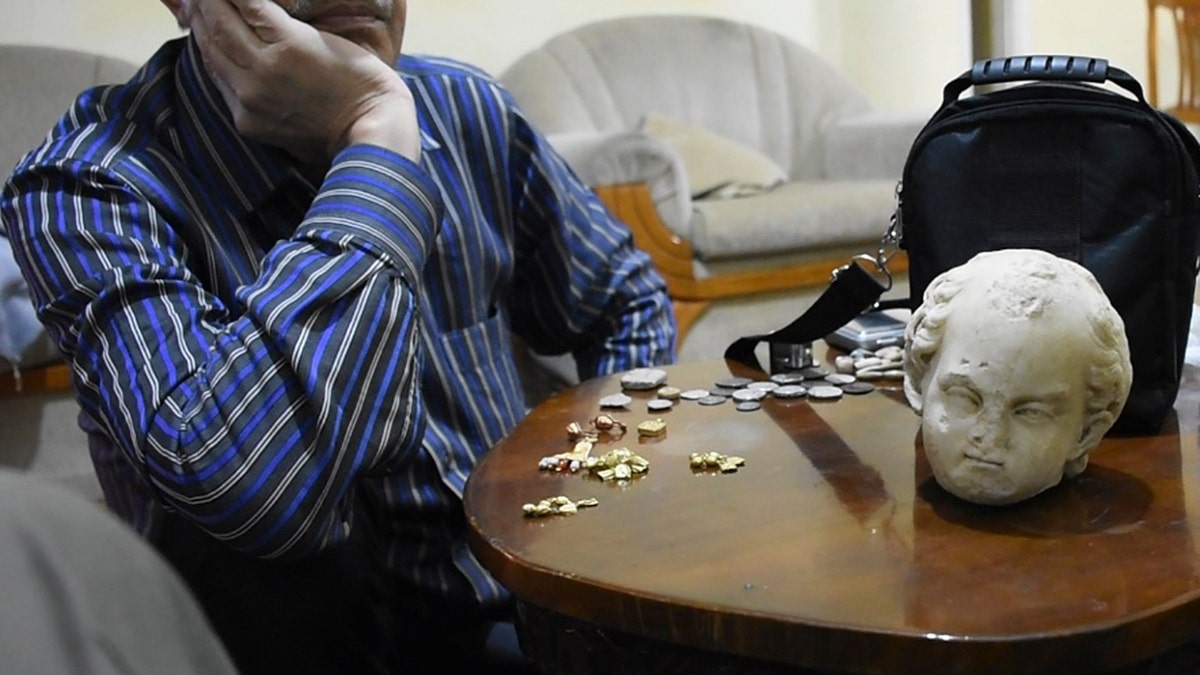
Mohammed, who escaped Syria in April of this year, reaps benefits from the full-fledged illicit trade of antiquities in Turkey. (Daham Alassad)
The Syrian Army reclaimed the city in March 2016, only for ISIS to invade successfully again in December. By early March 2017 the city was back in the hands of Syrian forces -- but littered with landmines to ensure more annihilation.
Mohammed estimated that ISIS destroyed around 15 percent of the artifacts in its reach, mostly to make propaganda videos to tell its followers that the items were forbidden in Islam. Despite being allegedly forbidden in Islam, the terror group discreetly went on to sell the vast majority to boost their bankroll.
"When I saw those videos of ISIS destroying them – I couldn’t sleep for days.”
Artifacts that survived the occupation and fighting have been trafficked globally -- routed not only through neighboring Turkey, but Jordan and Lebanon, as well. Palmyra locals told Fox News that several ISIS fighters are still lurking in nearby mountain areas, and the smuggling trade continues to flourish outside Syria’s borders.
Today, Mohammed, who escaped Syria in April of this year, reaps such benefit with a full-fledged illicit trade in Turkey.
“I have staff who still smuggle from different areas over the border for me,” he said. “And when I ran away I collected many antiques, and some I’m waiting to arrive here.”
Mohammed claimed that while “business is not as good as it used to be because the black market is now full of antiquities from Syria,” he still manages to sell his small goods, primarily to “customers from Germany, Italy and the Arab world.” He operates through word of mouth, closing his sales first by sending photos of the items to the potential customer, and if they like it they “pay half the price.” He then takes the item further south to a designated meeting point, where an interlocutor collects the rest of the money and transfers the item to its new owners’ hands.
“I keep my money in banks with different account numbers, or I transfer the money to gold,” Mohammed said, adding that he feels “no guilt” for bartering archaeological treasures. “I’m sending these artifacts out into the world, otherwise they would have been destroyed by the war.”

Graffiti sprayed by Islamic State militants which reads "We remain" is seen on a stone at the Temple of Bel in the historic city of Palmyra, in Homs Governorate, Syria April 1, 2016. (REUTERS/Omar Sanadiki)
SHOULD U.S. TAXPAYERS PAY TO REBUILD THE FORMER ISIS STRONGHOLD?
WHO ARE THE ISLAMIC MILITANTS LIKELY BEHIND THE DEATH OF AMERICAN SOLDIERS?
Palmyra native Daham Alasaad, who for several years before the Syrian war was a prominent Palmyra tour guide – observed Mohammed’s pilfered items up close, including an ancient Greek head and a statue of a Hercules God, and affirmed that they appeared to be authentic.
“It broke my heart seeing these items like this, and when I saw those videos of ISIS destroying them – I couldn’t sleep for days,” Alasaad said. “I was so proud of my ancient city.”
A representative from the Syrian government’s Directorate General of Antiquities and Museums told Fox News that they are close to finishing their “damage assessment” of the historic city -- using drones and 3D maps -- in an effort to determine next steps. And George Papagiannis, the media chief for the United Nations’ cultural body UNESCO said that they have not yet determined even if Palmyra will undergo repairs at all given that their guidelines only allow for reconstruction in “exceptional cases.”
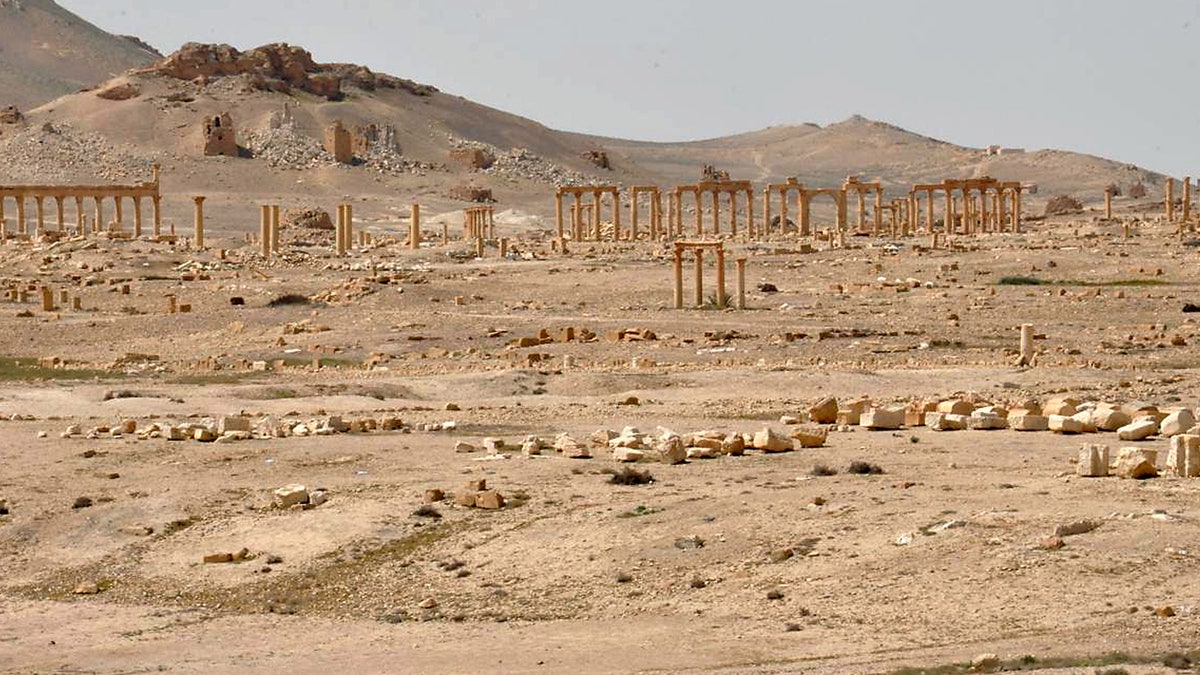
A general view inside the historic city of Palmyra, in Homs Governorate, March 27, 2016 (REUTERS/SANA)
“Discussions in the international scientific community have been ongoing since the first wave of intentional destructions hit Palmyra, ranging from keeping the destruction visible as a testimony of the tragic events that hit the site, to full reconstruction as a means to defy destruction,” he said. “We have not had the opportunity to fully evaluate the site and make that determination. The situation remains volatile in the whole area, and the roads leading to it are still military zones.”




















